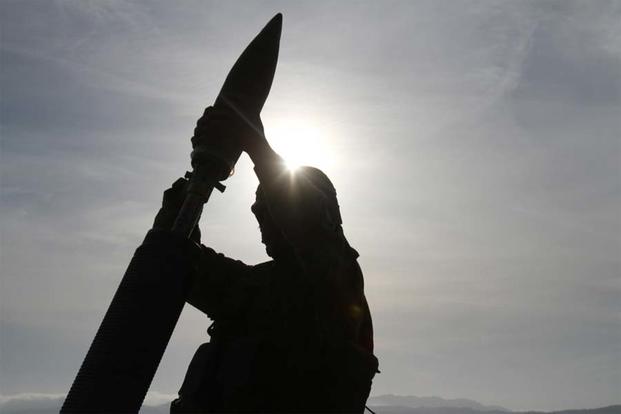QUANTICO, Virginia -- Last week, the Marine Corps' Next-Generation Logistics office quietly printed, and then detonated, an indirect fire munition at Naval Surface Warfare Center Indian Head, Maryland, in collaboration with the center.
Capt. Chris Wood, the co-lead for 3-D printing for Deputy Commandant of Installations and Logistics Lt. Gen. Michael Dana, declined to specify which indirect fire system was employed in the experiment, but said this test, the first of its kind for the Marine Corps, revealed a promising result.
The munition, he said, proved more lethal than traditionally manufactured munitions. And testing showed it could be developed to further improve lethality or otherwise tailor the system to the mission. In future, data suggest, Marines could wield weapons that are safer to use and more surgical in their impact, thanks to this new production method.
"One of the benefits of being able to precisely control the way that a munition or warhead is 'grown' through [additive manufacturing] is that we think we'll be able to tailor the blast and associated fragmentation to achieve specific effects for particular targets, heights, collateral damage, or even environmental considerations," Wood said. "Some of this can be done currently with very expensive, hand-made munitions, but [additive manufacturing] allows us to do it better, faster and likely cheaper."
And tailoring munitions is just one line of effort for the office known as NexLog, created to explore the impact of emerging technologies on Marine Corps logistics. Technologies such as additive manufacturing or 3-D printing, which can be cost-prohibitive for major part production, need more testing and evaluation before they could be incorporated into the larger supply chain.
"General Dana's insight was, most of my capabilities development takes 10 to 20 years," said Wood, who spoke to Military.com here Wednesday at the Modern Day Marine expo. "So if I don't start my experimentation and my advocacy for those things now, I'm not going to be able to really capitalize on what they can offer when they mature. We are fully aware that it's expensive, and it's not as mature as we want, but that's exactly why we think now is the perfect time to strike so we can figure out this very protracted capabilities development process."
For the Marine Corps, which has more than one aging vehicle model reaching the limits of its service life, 3-D printing can be a cost-effective way to manufacture parts no longer in production. Sometimes, Wood said, it's the only way. He cited the Marines' light armored vehicle, which is now expected to remain in service until 2035 -- more than three decades beyond its planned service life.
"Where production has been done for 20, 30 years, and they don't even assign [national service numbers] to some of these parts because they don't expect them to ever be replaced because they don't plan for that piece of equipment to go beyond that life cycle," Wood said. "That presents a huge challenge for program officers."
Another key use for the technology is in-field production -- a use well-suited to lower-cost polymer printers that might create temporary replacement parts for broken gear in order to extend mission effectiveness, even if only by a few hours.
"Rather than using duct tape and coat hangers and gum and all these other things, which literally occurs in the battlefield, we have this new design tool we can use," Wood said.
Fixes like these are already taking place within the fleet. Some 10 Marine Corps units are now equipped with 3-D printers, Wood said. Most are maintenance battalions, but several Marine Corps Forces Special Operations Command units and infantry and intelligence units are also equipped with the capability, he said.
While no units are manufacturing mission-critical parts, a more costly process and one that requires greater evaluation and scrutiny, polymer part production is proving to save time and cost. Marines printed a small plastic radio crypto key for roughly $2 that would have cost more than $70 to purchase, Wood said.
And Marine Corps leadership is urging non-aviation unit commanders to take advantage of this existing capability.
A Marine Corps administrative message released this month provided guidance for commanders at the rank of lieutenant colonel and above to commission 3-D printed replacements for non-critical equipment parts that are obsolete and don't require a data rights clearance prior to reproduction. The guidance also lays out a path for commanders to work through Marine Corps Systems Command to commission other 3-D printed materials.
One requirement: Parts must be printed in bright, non-standard colors such as yellow or green so their manufacturing origin is instantly recognizable.
"Our equipment program managers wanted to be certain that it was clear to any Marine which components might be printed on their equipment," Wood said. "This allows them to handle the component appropriately, know to report it if it fails unusually and generally track it uniquely from other components due to the nascent nature of the Marine Corps exploration of additive manufacturing."
Wood estimates the manufacture of permanent metal 3-D printed parts off the Marine Corps supply chain is a process still one or two decades from reaching maturity.
When a Marine Corps MV-22B Osprey took flight in August with two mission-critical titanium parts made through additive manufacturing, the process was labor-intensive, requiring extensive testing and qualification and heat treatment for the palm-sized parts, which included an engine nacelle link and stainless steel lever for the fire extinguishing system.
The printer itself cost about $900,000. Wood said Marine Corps aviation was still working to determine what its policy for 3-D printing technology would be.
In the meantime, the Marine Corps will continue to experiment, including more munitions testing in the near future.
"We plan to do that soon as possible," he said.
-- Hope Hodge Seck can be reached at hope.seck@military.com. Follow her on Twitter at @HopeSeck.

























